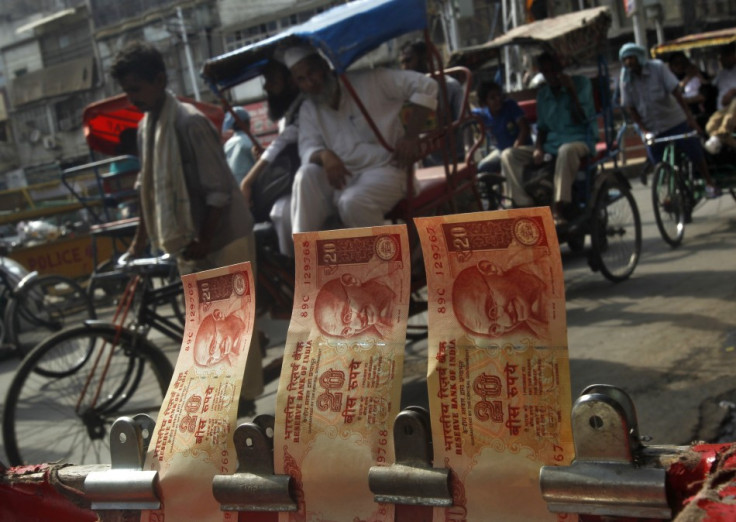India’s Rupee in Free Fall: Central Bank Unlikely to Shore up Currency

Where could the next big step for stemming the decline in the value of the rupee come from? India's central bank? Every finger points to that direction though there are several other steps the government has to initiate.
The Indian rupee struck a historic low of 58.98 to the US dollar on 11 June, when the Reserve Bank of India (RBI) reportedly stepped in to arrest a further decline in the value of the currency.
The RBI has by and large stayed away from intervening in the forex market in the recent past, and has recently flagged its preference to allow the rupee to be driven broadly by market forces, according to a Barclays report.
The rupee's fall may harm foreign investors who are investing their money in Indian stocks. The rupee has lost more than 5% against the dollar in the last one month alone, while it has fallen 4.8% in the last 12 months, according to The Indian Express.
The central bank remains hesitant to use its reserves for market intervention when the rupee is under pressure, primarily due to global reasons. However, it does not rule out using the reserves to contain volatility, especially if more idiosyncratic in nature, Barclays said.
Barclays's discussions with policymakers suggested the RBI might have a preferred range for the rupee, even if it is not explicit about it.
However, heavy-handed intervention is unlikely even if the USD/INR pair breaches their desired range, according to Barclays.
According to the report, there are others ways the government can arrest the fall in the Indian currency:
Withholding Tax: The withholding tax on government bonds has been reduced to 5%, from 20%. But Barclay's does not expect any further change in this rate in the short term.
FDI limits: The Indian government could raise the threshold for foreign direct investment (FDI) in the defence and telecommunication sectors that rely heavily on imports. Decisions could be taken by the end of June or early July. The move would help finance India's current account deficit in the near term, and reduce the deficit over the medium term, the report said.
Relaxation of foreign institutional investor (FII) investment limits in bonds: A further increase of $5bn to $10bn in the second half of 2013 is a possibility.
Gold demand reduction: India recently hiked the import duty on gold to 8% from 6% to curb gold imports, responsible for increasing its current account deficit. The RBI has also imposed a restriction on gold loans and has ordered agencies importing gold to do so on a 100% cash margin basis.
Raghuram Rajan, the chief economic adviser to the Indian government, expects a reduction in gold imports.
Non-Resident Indian (NRI) bonds: The government could issue US dollar denominated bonds similar to India millennium deposits, issued in 2000, or Resurgent India bonds, issued in 1998. Barclays opined the possibility of such an issuance taking place has increased in recent weeks.
Lower foreign investments in India's stock and debt markets and a wide current account deficit are partly responsible for pulling down the Indian rupee, Madan Sabnavis, chief economist at Mumbai-based Care Ratings, a credit rating agency, wrote in the New York Times.
Downbeat investor sentiments within and outside the country too are responsible for dragging down the rupee, he said.
Foreign institutional investors, who have invested in excess of $15bn in Indian stocks since January 2013, reportedly sold stocks worth £267m (€315m, $420m) from 12-14 June. They have also sold debt securities worth £2bn (€2.4bn, $3.2bn) so far this month, according to market regulator SEBI.
The benchmark S&P BSE Sensex has lost 1.3% in the year so far. Shares of Rajesh Exports, India's largest manufacturer and exporter of jewellery, have dropped 12% in the year so far.
In April, India reported a bigger trade deficit after the country imported gold worth $7.5bn that month, a 138% spike in imports year-on-year, to satisfy local demand. Getanjali Gems, a leading retailer of branded jewelry, has gained 1.6% in 2013.
Domestic sentiment is heavily influenced by government and RBI data, or the lack of any, about gold imports and the dollar/rupee rate. Either way, market reaction can be pessimistic, Sabnavis said.
A depreciated rupee makes Indian goods cheaper for the overseas buyer, aiding exporters for a while.
"All the IT companies will get a margin boost due to the rupee depreciation. Every one percent change in rupee boosts margins by 30-40 basis points," analyst Ankita Somani of Angel Broking said last week. A basis point is one-hundredth of a percentage point.
Oil refining major Reliance Industries and oil producer Cairn India stand to gain as well. "Every rupee 1 change in the INR/USD rate assumption impacts Reliance's EPS by about 3%," said Rohit Ahuja, analyst with ICICI Securities. "Cairn India gains considering its exposure to crude sales - crude in rupee terms has risen 4%."
The reasons behind the depreciated rupee may not be quite India-specific, but the consequences would, said Sajjid Z Chinoy, economist at JP Morgan.
India's wholesale price inflation fell to a 3.5-year low in May, but a near-term interest rate cut from the central bank is unlikely due to the recent fall in the value of the rupee.
"This is not of India's making over the last four, five days. Every emerging market has blared over the last week, but it is the emerging market current account deficit countries that have suffered the most," Chinoy said.
The RBI meets on 17 June and will announce its interest rate decision this week. "However, given the bleeding in the rupee, the RBI will very much stay on hold. A June rate cut is very much off the table, and if things don't stabilise, so will a July rate cut," Chinoy said.
© Copyright IBTimes 2024. All rights reserved.






